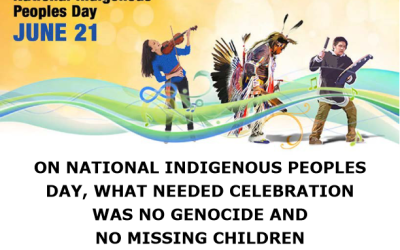The origin of a potentially groundbreaking step towards meaningful reconciliation between Canada’s first people and settlers can be laid at the feet of Métis leader Louis Riel. Literally. In 1994, Métis activist Jean Allard had lots of time to think after he chained himself to the controversial statue of a “tortured” Riel to protest its removal from the grounds of the Manitoba Legislature. As a former Indian Affairs (IA) project manager who was a member of the Legislature in Premier Ed Schreyer’s NDP government, he knew first-hand how ordinary First Nations (FN) people were being crushed under the weight of an enormous Indian Affairs bureaucracy.
As Allard sat in chains at the feet of Riel, he fretted about the damage done to communities by the battle for power and money that always flowed from the top down, controlled by IA. He greatly feared that the suffering of the people was without end; their poverty and suffering was the justification for keeping the money rolling for more and more IA programs. What if, Allard wondered, the money and power flowed to the ordinary people instead, with their leaders accountable to them? Treaty annuities were already being paid directly to every Treaty man, woman and child for the sharing of the land. But those annuities had been frozen at $5 (or $4 for some Treaties) for some 150 years. What if the Treaty annuity was modernized?
It was a remarkably simple and elegant solution. The individual annuities were written into the Robinson Huron and Superior treaties in 1850 as a promise to the first people to share in the prosperity of the settled lands through increasing annuities. But it was also a way of reducing the up-front costs of acquiring FN lands to make way for settlers, while deferring annuity costs into the future. The Robinson annuities increased only once, in 1878, when Parliament voted to increase the annuity from 96-cents per person to $4.
There was a strong case for modernizing the single provision in the Treaties for the benefit of individuals and families. Nearly every provision for the benefit of the collective had already been adapted to the modern era. The “pestilence and famine” and the “medicine chest” clauses in Treaty 6, for instance, had long since been “modernized” to mean social assistance and federal health care services for all FN communities. But the annuity remained frozen at $4 or $5.
Allard lost his battle to save the statue of his great-great-uncle, but he had a new cause. There was no legal barrier to increasing annuities. The Indian Act was silent on the value and distribution of the annuity. All it would take was the political will of the Prime Minister and federal Cabinet.
Wayne Helgason, the Ojibway executive director of the Social Planning Council of Winnipeg, saw a modern annuity as a game-changer for FN families, both on reserve and in cities like Winnipeg. It had the potential to immediately remove almost all FN families out of welfare dependency and control by IA so they could choose for themselves where and how they lived.
In 2002, Helgason and Allard put together a team of Indigenous and non-Indigenous men and women to examine a modern annuity. The Treaty Annuity Working Group hosted a national conference in 2003, and issued a report with four key recommendations. A modern annuity could work if the annuity was linked to modern land values, extended to all Status (Registered) Indians across Canada, paid directly to eligible recipients outside the control of Indian Affairs, and was revenue neutral.
The Working Group took its report to Ottawa, where it got the cold shoulder from the IA minister. Appeals to Prime Minister Jean Chrétien got lost in the high drama of the leadership feud between Chrétien and Paul Martin. And Martin, once he became PM, had his own plans for Indigenous policy and they didn’t include modernizing annuities.
Fifteen years later, times and attitudes in Canada have changed. The Truth and Reconciliation Commission (TRC) awakened people to the importance of reconciliation, and a new generation of FN leaders stepped to the fore. A modern annuity is now, more than ever, a powerful response to the TRC Calls to Action, and to the Missing and Murdered Indigenous Women and Girls Calls to Justice. It is the means for settlers to share the prosperity of the land with the first people.Such a revolutionary but logical idea should not require anyone to chain themselves to a statue. All it needs is the support of Canadians who value reconciliation. The politicians cannot act without it.



